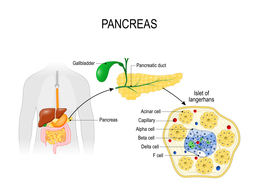Macroporous Polyethylene Glycol Scaffolds for Cell Transplantation
TECHNOLOGY NUMBER: 6957

OVERVIEW
A method to transplant islet cells onto microporous polyethylene glycol scaffolds- Transplanted islet cells sense blood glucose levels and produce insulin
- Post-transplant, local environment control permits the islet cells to thrive
BACKGROUND
Islet cell transplantation is a potential treatment option for patients with type 1 diabetes mellitus (DM), which is a chronic disease resulting from an autoimmune attack on the insulin-producing beta cells in the pancreas. As a result, patients with type 1 DM are unable to produce adequate insulin to regulate their blood sugar levels, resulting in an array of deleterious clinical repercussions. One treatment approach for this illness involves transplanting islets containing beta cells into a recipient's liver to help regulate blood sugar levels. The transplantation approach can be adversely affected by a recipient's immune system rejection of the transplanted islets, and use of this the procedure is limited by a relative lack of donors as well as its expense. Those limitations commonly relegate use of transplantation to clinical circumstances in which patients with DM suffer from clinical conditions which cannot be controlled by insulin therapy. As such, a need exists for a means to transplant islets into extrahepatic sites which enable engraftment and long-term functioning.
INNOVATION
Researchers have identified a method to transplant islet cells onto microporous polyethylene glycol (PEG) scaffolds that allow for revascularization of the transplanted islets. This approach provides the nutrients necessary for islet cell survival while also facilitating the ability to sense blood glucose levels and the distribution of insulin. While previous islet encapsulation technologies have been limited because they limit neovascularization and hinder mass transport of encapsulated cells, these microporous scaffolds are functionalized with extracellular matrix proteins and trophic factors to control the local environment. These refinements permit the microporous PEG hydrogel scaffolds to transplant islets or beta-cell progenitors to a clinically translatable, extrahepatic site, such as the peritoneum, omentum, muscle or epididymal fat. Additionally, the scaffolds may be functionalized with immune cytokines to modulate innate and adaptive immune responses to delay rejection or promote immune tolerance. The ability to control the local environment post-transplantation helps to account for the variance in islet cell quality between donors and provides a permissive environment where the islet cells can survive.